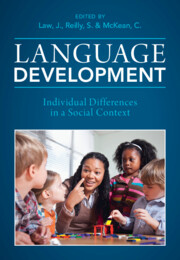Book contents
- Language Development
- Language Development
- Copyright page
- Contents
- Figures
- Tables
- Contributors
- A Tribute to Our Friend, Colleague and Fellow Editor, Professor James Law
- Introduction
- Part One Factors Influencing Language Development
- Part Two Continuity and Change
- Part Three Impact, Intervention and Equity
- 15 Communication, Participation and Cohort Studies
- 16 Capturing the Voice of Parents and Children
- 17 Oral Language Skills as a Foundation for Learning to Learn
- 18 The Economic Impact of Low Language Ability in Childhood
- 19 A Review of Interventions to Promote Language Development in Early Childhood
- 20 Interventions to Promote Language Development in Typical and Atypical Populations
- 21 The Effect of Kindergarten Instructional Policies on Reading and Math Achievement Gaps
- 22 Educational Interventions Targeting Language Development
- 23 Equity and Access to Services for Children with Language Difficulties
- Index
- References
22 - Educational Interventions Targeting Language Development
from Part Three - Impact, Intervention and Equity
Published online by Cambridge University Press: 11 August 2022
- Language Development
- Language Development
- Copyright page
- Contents
- Figures
- Tables
- Contributors
- A Tribute to Our Friend, Colleague and Fellow Editor, Professor James Law
- Introduction
- Part One Factors Influencing Language Development
- Part Two Continuity and Change
- Part Three Impact, Intervention and Equity
- 15 Communication, Participation and Cohort Studies
- 16 Capturing the Voice of Parents and Children
- 17 Oral Language Skills as a Foundation for Learning to Learn
- 18 The Economic Impact of Low Language Ability in Childhood
- 19 A Review of Interventions to Promote Language Development in Early Childhood
- 20 Interventions to Promote Language Development in Typical and Atypical Populations
- 21 The Effect of Kindergarten Instructional Policies on Reading and Math Achievement Gaps
- 22 Educational Interventions Targeting Language Development
- 23 Equity and Access to Services for Children with Language Difficulties
- Index
- References
Summary
There is a great need to develop and test school-based interventions that improve children’s language skills. These interventions can be used to support language development in all children as well as those with developmental disabilities affecting language, such as developmental language disorder (DLD). For young children in the pre-primary grades, these interventions aim to improve children’s readiness for formal schooling and the language demands on classroom settings. For children in the primary grades, these interventions are designed to improve the language skills considered most critical to reading comprehension, such as vocabulary knowledge and inferencing. This chapter addresses these contemporary issues. First, we describe language skills as a critical element of school readiness and an important contributor to reading comprehension. Second, we describe current approaches to facilitating language skills in pre-primary children via classroom-based interventions. Third, we describe current approaches to improving language skills in primary-grade pupils as a mechanism for improving reading comprehension. The over-arching purpose is to provide a contemporary overview of practices used in classroom settings to facilitate children’s language skills.
Keywords
- Type
- Chapter
- Information
- Language DevelopmentIndividual Differences in a Social Context, pp. 519 - 538Publisher: Cambridge University PressPrint publication year: 2022
References
- 2
- Cited by



